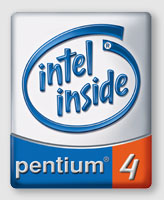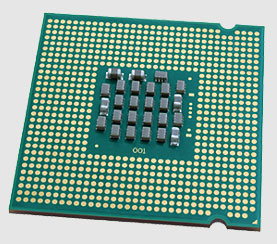|
Review
Intel P4P 660 and 3.73 Extreme Edition
by John Reynolds
Introduction
 Introduced
in late 2001, the Pentium 4 has enjoyed a long market life
for a mainstream CPU. Intel's early claims for their new architecture
revolved around deeper pipelines that would enable enormous
clock speed gains as new fabrication processes became available
over the years. Yet a curious thing happened between the P4's
market arrival and Intel's original, lofty 10 GHz claims,
something that's affecting all CPU manufacturers, which is
heat dissipation. There are other bumps along the road to
higher CPU speeds-such as wire delay, slowing process technology,
and the gradual creep of memory bandwidth-yet the greatest
hurdle is undoubtedly that of increased power due to larger
die sizes and higher frequencies, and the heat that is created
from this combination. And Intel's Prescott update to the
P4 architecture last summer has come to embody the roadblock
this thermal wall has erected across the path to 10 GHz CPUs.
Fortunately, core frequencies are not the only metric by which
to measure performance, and the CPU manufacturers have begun
shifting their engineering efforts and marketing focus more
and more away from relying almost solely upon clock speeds
as performance improvements. Introduced
in late 2001, the Pentium 4 has enjoyed a long market life
for a mainstream CPU. Intel's early claims for their new architecture
revolved around deeper pipelines that would enable enormous
clock speed gains as new fabrication processes became available
over the years. Yet a curious thing happened between the P4's
market arrival and Intel's original, lofty 10 GHz claims,
something that's affecting all CPU manufacturers, which is
heat dissipation. There are other bumps along the road to
higher CPU speeds-such as wire delay, slowing process technology,
and the gradual creep of memory bandwidth-yet the greatest
hurdle is undoubtedly that of increased power due to larger
die sizes and higher frequencies, and the heat that is created
from this combination. And Intel's Prescott update to the
P4 architecture last summer has come to embody the roadblock
this thermal wall has erected across the path to 10 GHz CPUs.
Fortunately, core frequencies are not the only metric by which
to measure performance, and the CPU manufacturers have begun
shifting their engineering efforts and marketing focus more
and more away from relying almost solely upon clock speeds
as performance improvements.
The newest desktop CPUs from Intel
being announced today are the P4P 660, a 3.6 GHz part, and
the 3.73 GHz Extreme Edition. Both processors are based on
the Prescott core and are therefore manufacturered using Intel's
90nm process. The 660 supports a 800 MHz FSB and the 3.73
EE continues the 3.46's support for the 1066 MHz FSB of Intel's
925XE chipset. The P4P 660 is the first part in a new sequence
of CPUs from Intel featuring 2 MB of L2 cache, an increase
over the 1 MB cache of the 5xx Prescotts last summer. The
cache structure for the 3.73 EE has also been changed from
that of previous Extreme Editions, which formerly consisted
of 512 KB of L2 and 2 MB of L3, to resemble that of the 660.
Yet according to Intel this reduction in total on-die cache
for their Extreme Editions should actually improve performance,
as larger caches have slightly higher latencies. Interestingly
enough, the larger cache is what lent the Extreme Edition
processors their label over mainstream P4s, but with the introduction
of the 6xx series we have a situation in which cache sizes
are now identical between the two product lines. When questioned
on the similarity of these new processors Intel stated that
they were working on ways to "soon" make their EE
CPUs more extreme.
 In
addition to the cache changes for both product lines, the
660 and 3.73 EE also support features new for Intel CPUs,
though not exactly new to the desktop CPU market: EM64T and
XD Bit. EM64T (Extended Memory 64 Technology) is Intel's support
for extended operating systems that will give compatibility
with 64-bit applications running under those OSes. While allowing
the CPU to access larger amounts of system memory-an increase
from 4 GB to 16 Exabytes-EM64T, essentially an extension to
Intel's 32-bit architecture, will not improve performance
for legacy code. XD (Execute Disable) Bit is similar to AMD's
EVP support, which is logic designed to prevent the running
of malicious code that attempts to execute in a memory area
marked as a data page, a common trick used by malware authors.
As with EVP, XD Bit requires Windows XP's Service Pack 2 to
be installed to function. In
addition to the cache changes for both product lines, the
660 and 3.73 EE also support features new for Intel CPUs,
though not exactly new to the desktop CPU market: EM64T and
XD Bit. EM64T (Extended Memory 64 Technology) is Intel's support
for extended operating systems that will give compatibility
with 64-bit applications running under those OSes. While allowing
the CPU to access larger amounts of system memory-an increase
from 4 GB to 16 Exabytes-EM64T, essentially an extension to
Intel's 32-bit architecture, will not improve performance
for legacy code. XD (Execute Disable) Bit is similar to AMD's
EVP support, which is logic designed to prevent the running
of malicious code that attempts to execute in a memory area
marked as a data page, a common trick used by malware authors.
As with EVP, XD Bit requires Windows XP's Service Pack 2 to
be installed to function.
The expected pricing for the
P4P 660 and 3.73 EE is $605 and $999 in 1,000-unit quantities,
respectively. Let's take a look and see if the 3.73's 1066
FSB support justifies its considerably higher price tag.
Test System Setup
- Intel
Pentium 4 660 (3.6 GHz) and 3.4, 3.46, and 3.73 Extreme
Edition CPUs
- Intel D925XECV2 (925XE) motherboard
- 1 GB (2x512 MB) Micron DDR2 533
MHz memory
- ATI Radeon X800 XT 256MB PCI Express
graphics card (Catalyst 5.1)
- Windows XP Professional (SP2)
- DirectX 9.0c
The benchmark suite used to evaluate
this test system is listed here.
As standard practice, 32-bit color and trilinear texture filtering
are the default baseline during testing. Anti-aliasing and
anisotropic texture filtering are, of course, disabled throughout
all tests, along with ATI's A.I. optimizations. Also, Windows
XP Professional is configured to have Automatic Update, System
Restore, and all unnecessary startup services disabled. And
the licensed version of Fraps 2.5.1 is used to record performance
scores unless otherwise noted. While SimHQ traditionally tests
the games included in our benchmark suite using high in-game
settings, because the clock speeds of the processors tested
are so similar, lower, less demanding, settings were used
to allow the CPUs to differentiate their performance scores,
if possible.
Go
To Page 2
Click
here to go to top of this page.
Copyright 2008, SimHQ.com. All Rights Reserved. Contact the webmaster.
|

